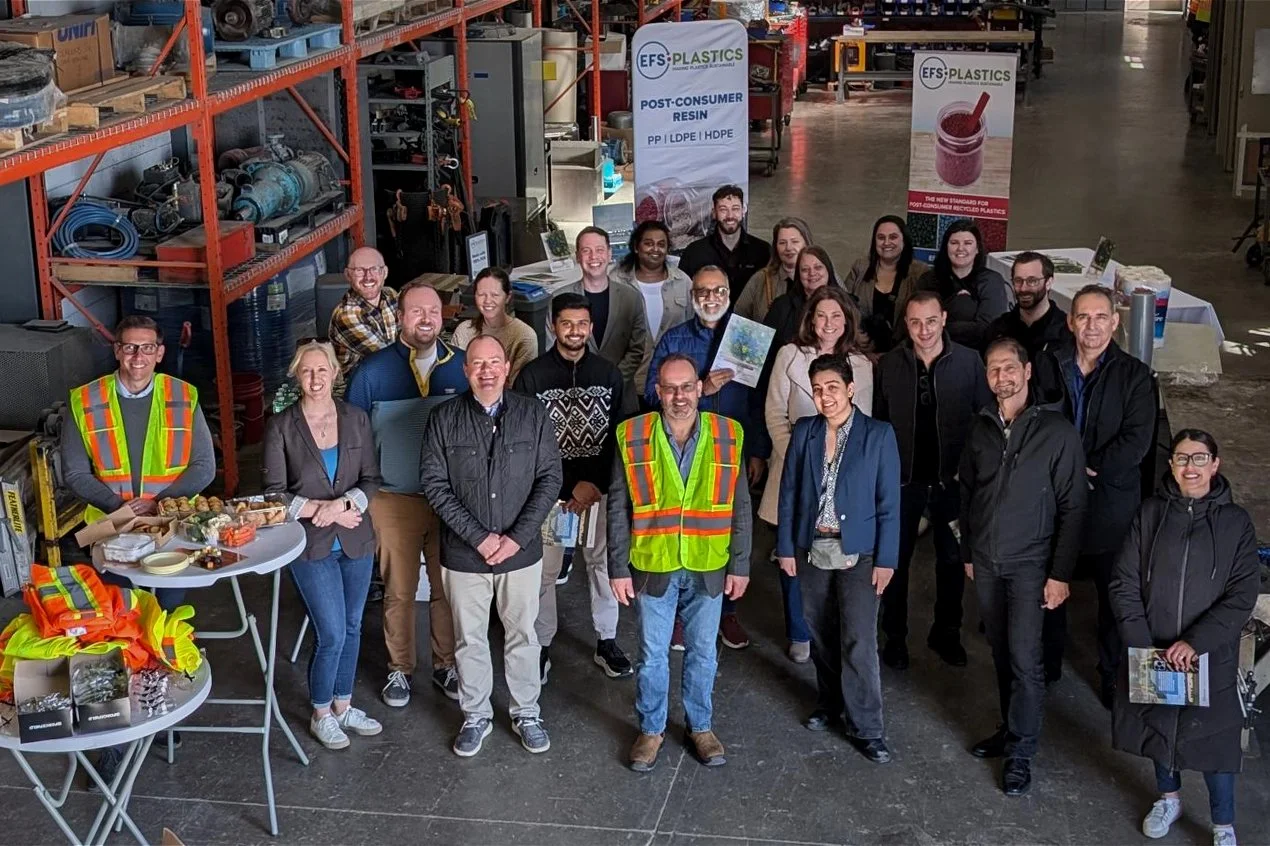How Well-Designed Policy Can Strengthen the Domestic Recycling Industry
Across the globe, the plastics recycling industry is under pressure. An oversupply of cheap virgin resin and low-cost imported recycled materials has pushed prices down and margins to the breaking point.
In Europe, several recyclers have shut down in recent months as the economics of recycling collapse under this pressure, and the same warning signs are appearing here at home, where even large, well-established producers are struggling to compete.
Canada and the US have tools like Extended Producer Responsibility (EPR) programs and recycled-content mandates. But these policies are often inconsistent, weakly enforced, or filled with exemptions that blunt their impact. Without a clear, consistent policy that rewards genuine circularity, protects local producers, and creates stable, long-term demand for recycled materials, the market will continue to favour virgin plastics and low-cost imports over verified, domestically sourced recycled content.
Yet before these policies can be implemented, it’s important to understand the challenges facing recyclers today.
Current Market Pressures and Economic Strain
Across North America, the economics of recycling are being undermined by cheap virgin resin, price volatility, and imported recycled materials that fail to meet domestic standards.
Markets are being increasingly challenged with low-cost imports of post-consumer recycled (PCR) plastics, particularly from Asia. These materials often lack chain-of-custody verification, meaning it’s difficult to confirm integration percentages of post-consumer recycled and post-industrial recycled (PIR) materials. While certain verification bodies claim that overseas companies are audited, it remains unclear how frequently on-site inspections occur to confirm compliance and track bale origins. In fact, some exporters may be labelling PIR as PCR, which inflates recycled-content claims and undermines legitimate domestic recyclers who process true post-consumer material.
The recent closure of rPlanet Earth, a Los Angeles-based PET recycler, underscores the seriousness of these challenges. In a statement confirming the closure, the Association of Plastic Recyclers (APR) cited that this was driven in part by brands choosing to buy imported rPET, a type of plastic that has been recycled from products like beverage bottles, to meet their US recycled content requirements instead of buying from domestic producers.
In terms of price, it’s an uneven playing field. Virgin resin made from fossil fuels becomes significantly cheaper when production outpaces demand, forcing producers to offload surplus material at low cost. This oversupply pushes down the market price of prime resin, tightening margins for recycled plastics and weakening demand for PCR content. As a result, investments in domestic recycling infrastructure often slow or stall.
While current market dynamics have undercut recyclers, well-designed policy can play a key role in strengthening the industry.
How Smart Policy Can Drive Change
There are several proven ways policy can shift market dynamics, from taxes that incentivize recycled content to tariffs that discourage dumping.
Implementing Tax on Non-Recycled Content
The United Kingdom’s Plastic Packaging Tax, introduced in 2022, applies to any plastic packaging made in or imported into the UK that contains less than 30% recycled content, taxing it at £223.69 (approximately $418 CAD) per tonne as of April 2025. Businesses must submit quarterly reports, maintain detailed records, and are subject to regular audits.
The results have been significant: manufacturers have been reformulating products to avoid the tax, and the average recycled content in non-exempt packaging is now approaching 30%. This single policy has boosted demand for PCR, proven the market can adapt quickly when given the right signals, and demonstrated that accountability mechanisms matter.
However, this doesn’t come without its loopholes. Some companies now import lower-cost PCR from Asia to meet compliance, which can undermine the domestic recycling benefits of the policy. If North American policymakers adopted this tax, it could rule that the recycled content used must come from the integrated trade zone under USMCA (formerly NAFTA) to reflect our geography and trade structure.
Reintroducing Tariffs on Imported Materials
Though tariffs are rarely ideal between allied markets, they could play a key role in preventing dumping of low-priced, unverifiable PCR imports from markets that undermine domestic recycling efforts and carry an outsized carbon cost from long-distance transport.
For example, the recent reapplication of tariffs imposed by the US on rPET imports could actually help strengthen the domestic recycling industry. Announced in September 2025, producers of imported resin will face a higher duty when previously it had been exempted.
Building Stability Between Brands and Recyclers
Policy could also help strengthen long-term supply and off-take agreements between brands and recyclers. These contracts create stability by ensuring a consistent flow of materials where brands commit to providing recyclables to recyclers, or recyclers commit to supplying recycled materials back to brands. This gives both sides predictability: brands know where their recycled inputs are coming from, and recyclers can count on steady demand for their products. However, most existing agreements are still short-term and heavily influenced by market price fluctuations.
The Retail Council of Canada visited EFS-plastics' Listowel facility for a rundown of our plastic recycling services.
The Path Forward
The collapse of recycling facilities in Europe, and now in North America, sends a clear warning: without strong, enforceable policy, circularity can’t compete with cheap virgin plastic.
This moment represents both a challenge and an opportunity: to move beyond reactive fixes and design the right policy vehicles to grow a truly circular plastics economy. By aligning economic incentives with environmental goals and ensuring that recycled content is verified, valued, and sourced locally, policymakers can secure the foundation for a resilient, self-sustaining North American circular economy.



